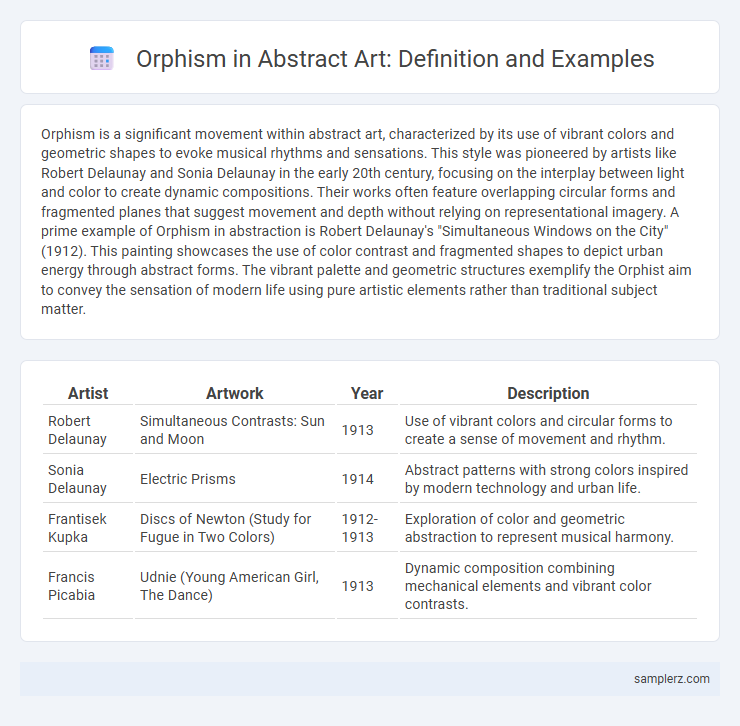Orphism is a significant movement within abstract art, characterized by its use of vibrant colors and geometric shapes to evoke musical rhythms and sensations. This style was pioneered by artists like Robert Delaunay and Sonia Delaunay in the early 20th century, focusing on the interplay between light and color to create dynamic compositions. Their works often feature overlapping circular forms and fragmented planes that suggest movement and depth without relying on representational imagery. A prime example of Orphism in abstraction is Robert Delaunay's "Simultaneous Windows on the City" (1912). This painting showcases the use of color contrast and fragmented shapes to depict urban energy through abstract forms. The vibrant palette and geometric structures exemplify the Orphist aim to convey the sensation of modern life using pure artistic elements rather than traditional subject matter.
Table of Comparison
| Artist | Artwork | Year | Description |
|---|---|---|---|
| Robert Delaunay | Simultaneous Contrasts: Sun and Moon | 1913 | Use of vibrant colors and circular forms to create a sense of movement and rhythm. |
| Sonia Delaunay | Electric Prisms | 1914 | Abstract patterns with strong colors inspired by modern technology and urban life. |
| Frantisek Kupka | Discs of Newton (Study for Fugue in Two Colors) | 1912-1913 | Exploration of color and geometric abstraction to represent musical harmony. |
| Francis Picabia | Udnie (Young American Girl, The Dance) | 1913 | Dynamic composition combining mechanical elements and vibrant color contrasts. |
Introduction to Orphism in Abstract Art
Orphism, pioneered by Robert Delaunay and Sonia Delaunay, revolutionized abstract art through its vibrant use of color and geometric forms. This movement emphasized pure abstraction and rhythmic composition, creating a sense of musicality and dynamism on the canvas. Key works like Robert Delaunay's "Simultaneous Contrasts" illustrate the interplay of light and color, defining Orphism's unique contribution to the evolution of modern art.
Defining Characteristics of Orphic Abstraction
Orphic Abstraction is characterized by vibrant colors, geometric shapes, and a rhythmic composition that evokes musical harmony. This style emphasizes the abstraction of form and luminous color contrasts to create a sense of dynamic movement and spiritual symbolism. Key artists such as Robert Delaunay and Sonia Delaunay pioneered Orphism by integrating Cubist fragmentation with Fauvist color vibrancy, pushing the boundaries of visual expression.
Key Orphist Artists and Their Influence
Orphism, a vibrant offshoot of Cubism, revolutionized abstraction through the use of bold colors and dynamic shapes. Key Orphist artists such as Robert Delaunay and Sonia Delaunay integrated lyrical rhythms and light effects, greatly influencing modern abstract art and later movements like Futurism and Abstract Expressionism. Their innovative techniques emphasized the harmonious interplay of color and form, establishing a foundation for color theory in contemporary visual arts.
Robert Delaunay: Pioneer of Orphism
Robert Delaunay revolutionized abstraction through Orphism by emphasizing vibrant color and dynamic form, moving beyond Cubism's monochromatic palette. His use of circular shapes and prismatic colors in works like "Simultaneous Windows" exemplifies Orphism's fusion of musical rhythm and visual sensation. Delaunay's pioneering techniques laid the foundation for color theory in abstract art, influencing modernist movements worldwide.
Sonia Delaunay and Chromatic Exploration
Sonia Delaunay exemplifies Orphism in abstraction through her vibrant use of color and geometric forms, which emphasize the rhythm and dynamic interplay of chromatic contrasts. Her work, such as the "Chromatic Exploration" series, showcases the innovative fusion of abstraction and color theory, pushing boundaries in visual perception. This approach highlights Orphism's core focus on light, color, and motion, making her a pivotal figure in early 20th-century abstract art.
Famous Orphist Artworks in Abstraction
Robert Delaunay's "Simultaneous Contrasts: Sun and Moon" exemplifies Orphism through its vibrant color contrasts and geometric abstraction, emphasizing the dynamic interplay of light and color. Sonia Delaunay's "Electric Prismes" emphasizes rhythmic patterns and prismatic color, showcasing the movement inherent in Orphist abstraction. Frantisek Kupka's "Discs of Newton" illustrates abstract forms inspired by color theory, embodying the Orphist focus on chromatic harmony and visual vibration.
Color Theory and Rhythm in Orphism
Orphism in abstraction emphasizes vibrant color theory, utilizing simultaneous contrast and chromatic harmony to create dynamic visual experiences. Artists like Robert Delaunay manipulated rhythmic color patterns to evoke movement and evoke musicality within the composition. This fusion of vivid hues and structured rhythms defines Orphism's innovative approach to abstract art.
Orphism’s Connection to Cubism and Futurism
Orphism, pioneered by Robert Delaunay, amplifies Cubism's fragmented forms through vibrant color and light, creating dynamic compositions that evoke movement and rhythm. This movement intersects with Futurism's fascination with speed and technology by incorporating overlapping planes and swirling patterns that suggest motion. Orphism's blend of geometric abstraction and chromatic intensity distinguishes it as a pivotal development linking Cubist structure with Futurist dynamism.
The Impact of Orphism on Modern Abstraction
Orphism, founded by Robert Delaunay and Sonia Delaunay, revolutionized modern abstraction by emphasizing vibrant colors and dynamic compositions that blurred the distinction between figurative and abstract art. The movement's innovative use of color harmony and circular forms influenced key abstract artists such as Frantisek Kupka and Albert Gleizes, leading to a more expressive, rhythmic visual language. Orphism's integration of color theory and simultaneity contributed to the development of lyrical abstraction and paved the way for later movements like Cubism and Futurism.
Contemporary Echoes of Orphism in Abstract Art
Orphism's vibrant use of color and geometric shapes profoundly influences contemporary abstract artists like Sarah Morris and Yaacov Agam, who reinterpret its principles through dynamic, multi-dimensional compositions. This movement's emphasis on light and rhythm resonates in digital and kinetic art forms, creating immersive visual experiences that echo Orphism's pursuit of synesthetic harmony. Exhibitions such as the Museum of Modern Art's recent showcase highlight Orphism's enduring impact on abstract expression and visual innovation in the 21st century.

example of orphism in abstraction Infographic
 samplerz.com
samplerz.com